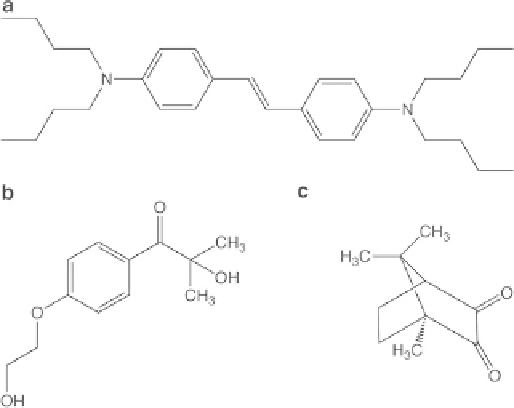Biomedical Engineering Reference
In-Depth Information
Fig. 9.8
Some typical photoinitiators used for (
a
) 2PP—an example of a strongly absorbing two
photon absorbing D-p-D chromophore, (
b
) general UV curing—Irgacure
®
2959, and (
c
) visible
light curing—camphorquinone
stability and reproducibility of the constructs. The light-induced radical crosslinking
of monomers and/or prepolymer solutions have established a quasi monopoly as a
hydrogel solidification strategy in combination with RP fabrication schemes. In the
case of the laser-based systems, this is even the fundament on which the respective
techniques are based and those are striking examples of one-step crosslinking
approaches. The chemical structures of some well-known photoinitiators are shown in
Fig.
9.8
. The first structure (Fig.
9.8a
) is an example of a D-p-D chromophore, known
for its high sensitivity in 2PP processes [
245,
246
] . The p-part is a conjugated back-
bone symmetrically substituted at the ends by electron-donating D-parts. Figure
9.8(b)
represents the chemical structure of Irgacure
®
2959 (I2959), a commonly applied pho-
toinitiator thanks to its high biocompatibility. It is known to absorb light in the UV
range. The last structure represents camphorquinone (CQ; Fig.
9.8c
), an initiator with
many dental applications and visible light working range.
Different reactive thermo-sensitive thiolated systems were developed in the past
[
247-
254
]. Thiol, vinyl or allyl ether polymerization display some advantages: mild
reaction conditions, photon initiator not necessary, low or even no oxygen inhibition
effects, fast process, forming of crosslinked networks with good physical and mechan-
ical properties [
255
] and degradable in (mimicked) physiological conditions [
256
] .
The so-called tandem reaction consists of two steps. The first step is the occur-
rence of rapid gelation kinetics. The second step involves a covalent curing based
on the Michael-type addition. This technique allows to create covalently bonded
hydrogels in combination with functional cells [
257
] under physiological condi-
tions, with no side reactions with bioactive molecules.

Search WWH ::

Custom Search